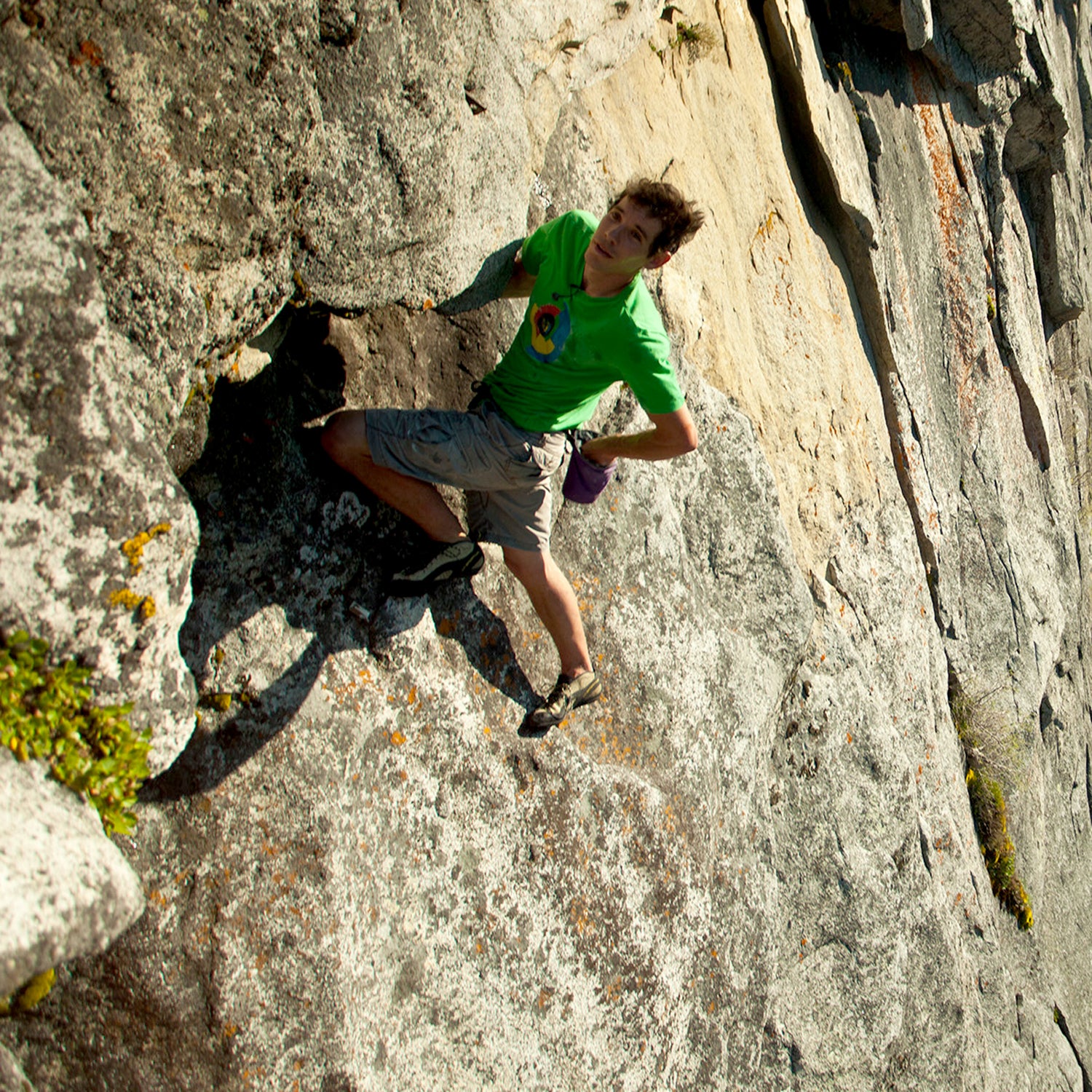The night before the launch of his first book tour, a month-long sprint through 20 cities across the U.S., Alex Honnold was laid over in Chicago en route to Boston, negotiating with an airline service rep. His plane had been held up for mechanical reasons, and Honnold needed to make sure he and his luggage would be at a venue in Portsmouth, New Hampshire, by Tuesday┬Āfor the official release of his first book, , a chronicle of his personal life and most memorable climbs, which he co-wrote with accomplished climber and author┬ĀDavid Roberts.
He was coming from the Banff Mountain Film and Book Festival in Alberta, where heŌĆÖd talked up his book during a speaking event with writer and climber Greg Child. HonnoldŌĆÖs two latest films, and , both in this yearŌĆÖs Reel Rock film tour lineup, screened at the festival and won awards for Best Climbing Film and Radical Reels PeopleŌĆÖs Choice, respectively. A Line Across the Sky is an epic portrayal of HonnoldŌĆÖs and fellow climber Tommy CaldwellŌĆÖs historic traverse across the snowy, jagged Fitz Roy mountain in Patagonia. But Horseshoe Hell is a mellower, goofier segment about a raucous all-day sport climbing competition in Arkansas, and Honnold seemed confused about its warm reception. ŌĆ£ItŌĆÖs a tribute to how weak the other films in the category were,ŌĆØ he said.
At the airport terminal desk, after arranging for his checked bag to fly with him to Boston, and somehow landing a first-class upgrade, the 30-year-old Honnold took a few minutes on the phone to catch ║┌┴Ž│į╣Ž═° up on the book, the tour, and how heŌĆÖs going to survive a month away from the crag.
OUTSIDE: One month doesnŌĆÖt sound like a very long book tour. ArenŌĆÖt they usually like two or three months?
HONNOLD: I donŌĆÖt want to take two or three months away from climbing, so IŌĆÖm cramming the whole thing into the month of NovemberŌĆöbasically a city a day. IŌĆÖm probably doing the same number of events of a usual book tour but in a month. I block my time like that. This winter IŌĆÖll be fully in the van, doing my thing.
You okay being away from climbing for that long?┬Ā
I actually just came off a month-long tour of South America and IŌĆÖve gotten into a disciplined ┬Āprogram. For this tour IŌĆÖm trying to do the same thing again with a month-long training circuit. Because IŌĆÖm constantly climbing IŌĆÖve never taken the time to do discipline training, so this is a good opportunity for that. I checked a bag with a pull-up bar and hangboard. Just those and clothesŌĆöthatŌĆÖs my whole travel scene right now.
Wait, youŌĆÖre setting up the hangboard in hotel rooms each night? How does that work?┬Ā
The pull-up bar has a cinch, so I set that up in the doorway and tie on the hangboard below the pull up bar with cord. ItŌĆÖs kind of a ghetto system but it works.┬Ā
What do you hope to get out of this tour?
ItŌĆÖs a totally new experience for me. I signed up for it for life experience. ItŌĆÖs a thing you do once. I have no huge expectationsŌĆöhoping to sell some books, I guess.┬ĀThe crazy schedule is definitely next-level for me. ItŌĆÖs kind of an interesting case study in what a true Hollywood celebrity goes through in promoting films when you have wall-to-wall press stuff every day. IŌĆÖm getting the one-month Brad Pitt experience.┬Ā
Why was it time for a book? What do you hope people better understand about you?
There are a lot of pieces of my story all over the place in blogs and magazines and videos and spread across the Internet and itŌĆÖs nice for me to be able to put them in one place. It just seems like the timing is right. If youŌĆÖre gonna write a book like that, you might as well do it when someone cares.
It's also about conveying the sheer volume of climbing IŌĆÖve done. In reality the soloing is a small percentage of my total climbing. The book is structured around my big eventsŌĆ” but it also covers a lot of my traveling and expeditions and gives a sense of the day-to-day climbing and volume of what I do. Hopefully that makes what I do with free soloing seem slightly more normal to people. I hate how people have the impression that I just do these crazy things and donŌĆÖt see the overall lifestyle that they fit into.
In the book, you say┬Āthat free-soloing big walls is ŌĆ£all about preparationŌĆØ and ŌĆ£just a matter of executing.ŌĆØ That sounds like something Dean Potter said about his work, and you give him an acknowledgement at the end of the book. What else have you learned from Dean?
ItŌĆÖs been weird re-reading the sections with Dean and thinking about it from the perspective of him having a terrible accident, because we wrote it before he died. Right after he died, I spent a couple days thinking of the achievement treadmill of constantly trying to do harder and harder things and push yourself. You do dangerous things and it becomes a dangerous treadmill. He spent his whole life at the edge, pushing the limits, and I think about that with my own climbing. You donŌĆÖt want to be at the edge for too long.
That definitely comes through toward the end of the book when youŌĆÖre contemplating turning 30 and the trajectories of older climbersŌĆösome who died in seemingly freak climbing accidents and others who are alive and still climbing today. Are you turning a page from free soloing?
Not at all. Two weeks before the Fitz traverse [in Patagonia] I soloed Sendero Luminoso [in Mexico] and University Wall [in Canada]. IŌĆÖm definitely still venturing along that path.┬ĀRight now IŌĆÖm deep in travel and work mode but IŌĆÖm training pretty hard. For the next year I wonŌĆÖt be doing as many work events and weŌĆÖll see where the climbing takes me.


